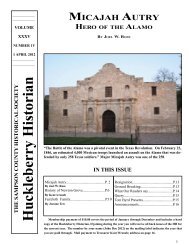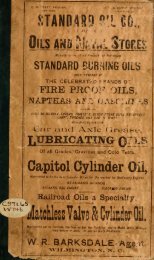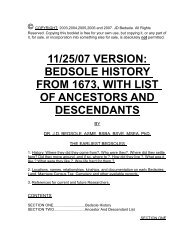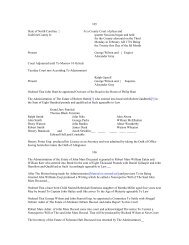Bedsole History from 1673 With Documentation - NCGenWeb
Bedsole History from 1673 With Documentation - NCGenWeb
Bedsole History from 1673 With Documentation - NCGenWeb
Create successful ePaper yourself
Turn your PDF publications into a flip-book with our unique Google optimized e-Paper software.
I remember one case in my own life, back in the 1930’s, when a fifteen year old neighbor of our’s was riding<br />
their mule <strong>from</strong> the field to the barn one late afternoon, when the mule suddenly went into a fit of rage,<br />
bucking and kicking and threw the boy head over heels up in the air. He landed on his back on top of a stump<br />
about thirty inches high. It broke his back in several places and there was nothing at all the doctors could do<br />
for that kind of injury in the 1930's. He was bedridden and his parents had the difficult job of turning him<br />
every few hours, all day and all night, until he finaly died, almost two weeks later. I can still hear him<br />
screaming every time they tried to move him. I cannot imagine the suffering and torture he and his parents<br />
had to live through, during that time.<br />
Planting Time<br />
In early spring, the cleared land had to be plowed under with a plow pulled by two mules, or oxen which were<br />
more plentiful than mules. These plows had a kind of steel “wing” on them, which turned a strip of dirt about 6<br />
inches wide, upside down and when a field was finished, it was ready for planting. Imagine plowing a field of<br />
200 acres, 6 inches at a time, taking about 20 minutes for one pass, or <strong>from</strong> one end of the field to the other.<br />
The amount of time and the walking and handling of the plow and team was very demanding, difficult and<br />
time-consuming.<br />
Once the field was prepared for planting, if not already on hand, the corn, cotton or other seeds had to be<br />
somehow acquired, either through purchase or some kind of trade. Corn was planted with two kernels every<br />
30 inches. An extra kernel, in case the first didn’t sprout. We now know that corn planters in modern day<br />
Nebraska and Kansas, successfully plant 90 or more seeds in the same 30 inch strip, producing 30 to 50<br />
times as much corn on the same piece of land. Nevertheless, the old way of planting persisted until about<br />
1950.<br />
So the harvest back then was pitifully small for all crops, due to the ignorance of the settlers, further<br />
worsening their already pathetically deprived lives, due to small crop yields. Low production also meant they<br />
had less to eat and to trade, for things they desperately needed all year long. The reason they planted so few<br />
seeds was the belief that they would “overplant” and “Burn out” the land. At a time when their very survival<br />
depended upon their ability to produce, their actual knowledge, beliefs and actions in such production was<br />
vastly inadequate and contrary to their needs for production, survival consumption, and prosperity.<br />
Bedding Cane<br />
This was a long, hard job done in the fall, when everybody cut down the stalks of cane, dug a hole about four<br />
feet deep and sixty feet long, piled the stalks in it and covered them with about three feet of dirt. This was to<br />
preserve the cane through the winter and keep it <strong>from</strong> freezing and bursting, thereby becoming useless.<br />
However, during the coldest part of winter, some cane would be uncovered and the leaves stripped <strong>from</strong><br />
each stalk, the stalks chopped into one-foot lengths and each piece planted in the field in preparation for<br />
growing and harvesting it and making syrup. This was a hated and dreaded job, because the cane was<br />
covered with ice in the winter and without gloves, the hands would freeze and become numb and then, over<br />
and over, had to be thawed out so they would work again. This meant frequent periods of excruciating pain<br />
when they were thawing out. Nobody had gloves back then and even if some had been available, the<br />
<strong>Bedsole</strong>s could not have afforded them, as they were considered an unnecessary “luxury”.<br />
Making Syrup<br />
This was another back-breaking job, always performed in the worst of winter, usually January and February,<br />
because this was a period of relative “down time” in the fields and farming. The cane, which had been cut










